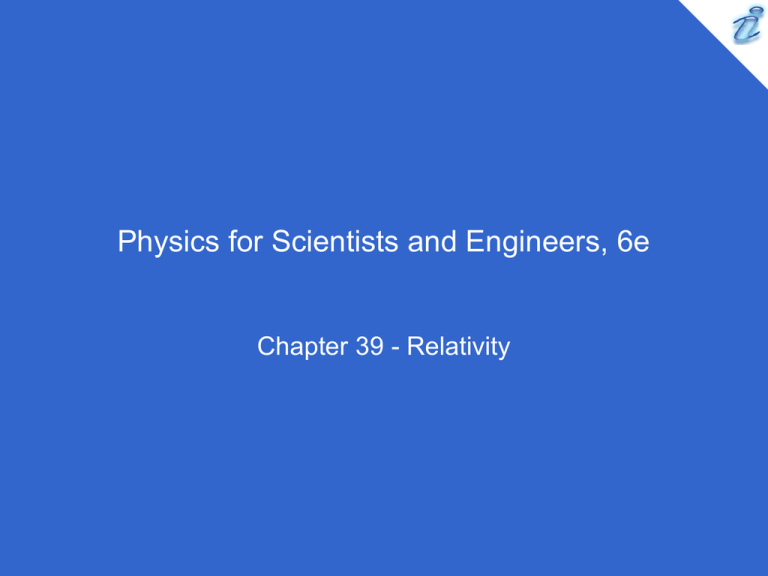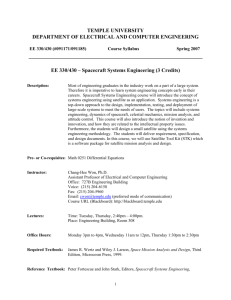Serway_PSE_quick_ch39
advertisement

Physics for Scientists and Engineers, 6e Chapter 39 - Relativity Which observer in the figure below sees the ball’s correct path? 1 1. the observer in the truck 2. the observer on the ground 3. both observers 2 3 4 5 33% 1 33% 2 33% 3 While the observers’ measurements differ, both are correct. A baseball pitcher with a 90-mi/h fastball throws a ball while standing on a railroad flatcar moving at 110 mi/h. The ball is thrown in the same direction as that of the velocity of the train. Applying the Galilean velocity transformation equation, the speed of the ball relative to the Earth is 1. 90 mi/h 2. 110 mi/h 3. 20 mi/h 4. 200 mi/h 5. impossible to determine 1 2 3 4 5 20% 20% 20% 20% 20% 1 2 3 4 5 The Galilean velocity transformation gives us ux = u’x + v = 110 mi/h + 90 mi/h = 200 mi/h. Suppose the observer O’ on the train in the figure below aims her flashlight at the far wall of the boxcar and turns it on and off, sending a pulse of light toward the far wall. Both O’ and O measure the time interval between when the pulse leaves the flashlight and it hits the far wall. Which observer measures the proper time interval between these two events? 1. 2. 3. 4. 1 2 O’ O both observers neither observer 3 4 5 25% 25% 25% 25% 1 2 3 4 A crew watches a movie that is two hours long in a spacecraft that is moving at high speed through space. An Earthbound observer, who is watching the movie through a powerful telescope, will measure the duration of the movie to be 1 1. longer than 2. shorter than 3. equal to two hours 2 3 4 5 33% 1 33% 2 33% 3 The two events are the beginning and the end of the movie, both of which take place at rest with respect to the spacecraft crew. Thus, the crew measures the proper time interval of 2 h. Any observer in motion with respect to the spacecraft, which includes the observer on Earth, will measure a longer time interval due to time dilation Suppose astronauts are paid according to the amount of time they spend traveling in space. After a long voyage traveling at a speed approaching c, a crew would probably rather be paid according to 1 1. an Earth-based clock 2. their spacecraft’s clock 3. either clock 2 3 4 5 33% 1 33% 2 33% 3 If their on-duty time is based on clocks that remain on the Earth, they will have larger paychecks. A shorter time interval will have passed for the astronauts in their frame of reference than for their employer back on the Earth. You are packing for a trip to another star. During the journey, you will be traveling at 0.99c. You are trying to decide whether you should buy smaller sizes of your clothing, because you will be thinner on your trip, due to length contraction. Also, you are considering saving money by reserving a smaller cabin to sleep in, because you will be shorter when you lie down. You should: 1 1. buy smaller sizes of clothing 2. reserve a smaller cabin 3. do neither of these 4. do both of these 2 3 4 5 25% 25% 25% 25% 1 2 3 4 Both your body and your sleeping cabin are at rest in your reference frame; thus, they will have their proper length according to you. There will be no change in measured lengths of objects, including yourself, within your spacecraft. You are observing a spacecraft moving away from you. You measure it to be shorter than when it was at rest on the ground next to you. You also see a clock through the spacecraft window, and you observe that the passage of time on the clock is measured to be slower than that of the watch on your wrist. Compared to when the spacecraft was on the ground, what do you measure if the spacecraft turns around and comes toward you at the same speed? 25% 25% 25% 25% 1 1. The spacecraft is measured to be longer and the clock runs faster. 2. The spacecraft is measured to be longer and the clock runs slower. 3. The spacecraft is measured to be shorter and the clock runs faster. 4. The spacecraft is measured to be shorter and the clock runs slower. 2 3 4 5 1 2 3 4 Time dilation and length contraction depend only on the relative speed of one observer relative to another, not on whether the observers are receding or approaching each other. You are driving on a freeway at a relativistic speed. Straight ahead of you, a technician standing on the ground turns on a searchlight and a beam of light moves exactly vertically upward, as seen by the technician. As you observe the beam of light, you measure the magnitude of the vertical component of its velocity as 33% 1 1. equal to c 2. greater than c 3. less than c 2 3 4 5 1 33% 2 33% 3 Because of your motion toward the source of the light, the light beam has a horizontal component of velocity as measured by you. The magnitude of the vector sum of the horizontal and vertical component vectors must be equal to c, so the magnitude of the vertical component must be smaller than c. Consider the situation in question 8 again. If the technician aims the searchlight directly at you instead of upward, you measure the magnitude of the horizontal component of its velocity as 1 1. equal to c 2. greater than c 3. less than c 2 3 4 5 33% 1 33% 2 33% 3 In this case, there is only a horizontal component of the velocity of the light, and you must measure a speed of c.







